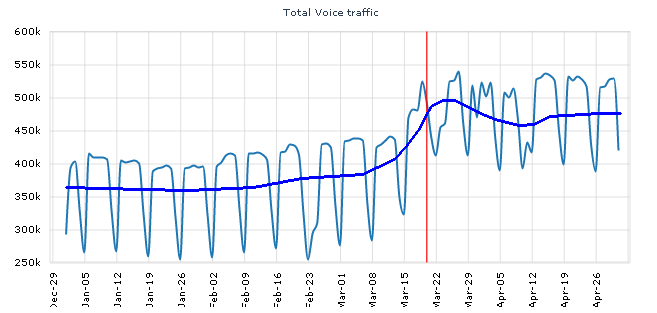How COVID-19 has changed the telecom traffic

May 13, 2020
With the ongoing coronavirus pandemic, nations changed their routines and the whole world is facing an unprecedented global situation
We are living strange times. The COVID-19 pandemic has made the whole world take a step back and slow down. Governments and health care systems throughout the globe are tackling the challenges and new scenarios imposed by the spread of the virus.
In the last months, entire countries adopted the lockdown, where people can’t leave home unless they really need to. Only essential services are still running and the only professionals we can find walking around the cities are the ones that work in those places – health care and public security workers, people that have jobs in supermarkets, pharmacies and so on.
All of this means that billions of people changed their daily routines completely. With the government’s instructions telling the population to stay at home, companies quickly started to adapt their business and day-to-day tasks to send their employees to work from home. Also, schools and universities are closed, so students can stay home.
With an increasing number of people and families having to turn their homes into offices and organize spaces for children and young adults to study, a lot of work started to take place to ensure that everyone can continue with their lives as normally as they can.
As we can see, most aspects of our lives have changed in these past months and no one knows when things can go back to normal. One thing is sure: with self-isolation and social distancing measures, telecommunications became a highly demanded and essential service. But how will the communications service providers keep their networks robust, reliable, and efficient?
The new normal and the telecommunications peak
In normal times, where there is no pandemic, no social distancing, no “lockout”, the typical demands of mobile networks have two main spikes:
During lunchtime – people leave their work and wi-fi connections and use the network to catch up on their social media, watch videos, and more.
End of the afternoon/beginning of the night time – when people are going home or going out to socialize.
On the weekends the mobile traffic has more flatter usage. That happens because people go out at different times during the day, making the traffic levels more linear – but of course that this depends on the geographical location and time of the year.
But now, everything has changed. In the normal scenario, telecommunications companies usually need millions of daily handovers between different parts of its network to suppress mobile demand. However, now, with almost everyone staying home, working, studying, working out inside, the demand has changed.
Telecom companies now are more focused on ensuring that there is enough network capacity throughout the whole day. Not only during the spike times, because the increase in static traffic grew exponentially. The daily handovers became a second priority as they decreased since the beginning of the COVID-19 pandemic.
The demands on networks are now much more constant and the traffic curves have flattened during business hours. Most people are staying home and using their wi-fi coverage. And more, on the weekends, the network demand is still high. But why is that? People are communicating much more than normal and, since they are staying home, they use more streaming platforms, on-demand videos, social media channels, etc.
But none of that means that people stopped using their mobile networks. Even at home, they still use their mobile phones to make calls. And, the need for social distancing, drives people to call more their families and friends. A research made by Bwtech in their South American networks showed that all that usage increased the voice traffic and the network demand since the pandemic and social distancing measures started. The chart below illustrates that the increase is around 25% in one of the countries investigated – the red line represents when the lockdown started.

How can telecom companies prepare for the high demand?
In this new scenario, telecommunications companies need to prepare for the ongoing increase of demand on their networks. Streaming services – such as Netflix and Google – have already announced the diminution of the quality of their video streamings from high definition (HD) to standard definition (SD) to prevent the network overload.
On the other hand, many countries started to escalate the use of telemedicine solutions, which also increased data traffic. This means that network engineers need to be more aware of their network anomalies, congestions, availability, faults, traffic trends.
With all that said, we can point out that telecom companies need to find new ways to monitor their networks more constantly, with more accurate tools and technologies. All to secure their signal quality and the robustness and efficiency of their network.
How can they do that?
Proactive approach: staying more aware of the warning signs, studying the ‘volume drivers’ with more attention to understanding new capacity requirements as they appear, making not only predictive analysis but also the modeling of capacity requirements.
Automation and AI: those two enable operators to implement solutions far more quickly and efficiently, besides giving the advantage to ensure that new pressures do not overwhelm networks.
Transforming time frames: modeling in the short term and being agile to meet demand is essential, so starting to use a 24-hour period not only to model but to also predict traffic trends can be essential to establish the world’s ability to stay at home (working and doing daily activities from there) and be safe.
Now, more than ever not only the market, but everyone is seeing the power that the telecommunications industry has. They make it possible to bring people together through the internet during the difficult times of social distancing. They also help people to get information and supplies without having the need to leave their homes. They allow our children to continue with their education when schools and universities are shut down. They entertain us and give us an option to pass the time. Never before have networks been more critical.
Automation and artificial intelligence to optimize networks
As said before, one thing that telecommunications companies can do to be prepared for the increase of demand and to maintain their network quality and efficiency is to use automation and artificial intelligence (AI).
Bwtech has a solution that takes advantage of state of the art Machine Learning algorithms to correlate data sources collected by NetChart – our main product – to provide actionable insights for network optimization. It is the NetWarden module.
Currently, engineers perform network optimization manually or using rule-based algorithms. As modern networks evolve and become more complex, these algorithms quickly become obsolete or no longer viable.
Therefore, the use of Machine Learning algorithms allows engineers to automatize their activities and identify complex network issues that can not be detected by humans or with traditional, rule-based approaches.
This solution has the main goal to automate the process of detecting issues in cellular networks, automate necessary analytical tasks and, as a result, significantly reduce the effort needed to keep the network in a good shape. All of this is possible because NetWarden learns what is a normal behavior of each individual network element and triggers an anomaly warning when any of the monitored performance indicators moves out of the expected range.
NetWarden is a solution that helps engineers to concentrate on taking important troubleshooting actions instead of spending many laborious hours on manual collecting, analyzing, and correlating the data by themselves.
With all the challenges that COVID-19 has brought upon Mobiles Operators, the urgency to provide even better and faster network services is one of the most critical aspects faced by the telecom industry. That being said, the use of Machine Learning for monitoring and optimization is one great way to combine the use of an advanced tool to proactively optimize the network performance.
